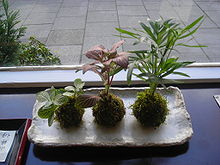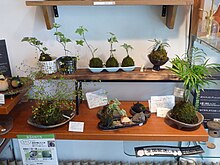

Kokedama (苔玉, in English, literally "moss ball") is a ball of soil, covered with moss, on which an ornamental plant grows. The idea has its origins in Japan, where it is a combination of the nearai (根洗い literally "root wash," but meaning "no pot") bonsai and kusamono planting styles. Today, Kokedama is very popular in Japanese gardens.
Creation
Kokedama is also called poor man's bonsai. It is made of wet akadama soil and keto (peat) formed to a ball. The plant is set into the ball and afterwards the moss is wrapped around. Aluminium wire or nylon wire fixes the whole bundle, and is sometimes used to suspend the kokedama in the air.
Care

Kokedama must be watered regularly. One method suggests feeling the weight of the kokedama over time – when the ball feels light, it can be submerged in water. The best plants for kokedama making are ones that require medium to full shade, since direct sunlight will likely burn and ultimately turn the kokedama a shade of brown.
References
- Kokedama Info, archived from the original on 2016-06-17
- ^ Martin, Tovah. "Gardening trends: The rise of 'kokedama'". The Telegraph. No. 1 December 2012. Retrieved 5 October 2014.
External links
 Media related to Kokedama at Wikimedia Commons
Media related to Kokedama at Wikimedia Commons